
Cost Effectiveness of Temporary Storage Tents in Non - Residential Sector

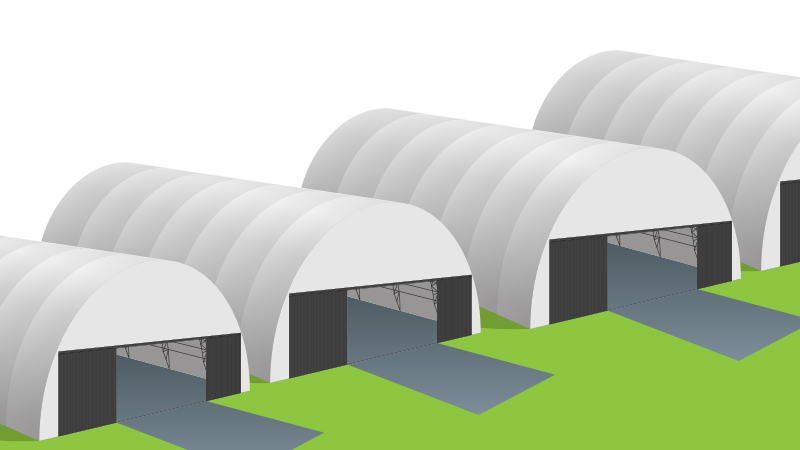
Abstract
The global construction industry is expected to grow by an average rate of around 3–4 percent between 2018 and 2022. The U.S., China, and India expected to hold an approximate 50 percent of shares worth $87 trillion in incremental construction to be spent over the next 15 years. North America is expected to grow at a compound annual growth rate (CAGR) of 4–5 percent to reach $1.78 trillion in 2019, with an increase in investment in the industrial, public, and residential construction activities. In the next 1–2 years, labor shortage in the U.S., and the retiring population in Canada are expected to lead to an increase in labor cost by 3–5 percent in the North American construction industry. The cost of construction materials is expected to increase by 2.4 percent in 2019 compared to the previous year driven by the tight labor market and a growing marketplace.
The European construction market is valued at $2.8 trillion (2018), accounting for approximately 25 percent of the total world’s construction output. More than 10 percent of total construction output is contributed by the industrial sector, and the commercial and retail sector contributes more than 15 percent of the total market. The construction market in Asia Pacific (APAC) is expected to grow at a CAGR of 4–5 percent between 2018 and 2022. The “Made in China 2025” initiative is expected to drive the demand for construction in the manufacturing sector. Increasing labor costs and workforce shortages are the major reasons for the unattractiveness of the Chinese construction industry.
The industrial sector is one of the fastest growing sectors with construction needs growing at a rapid pace across economies. The major constraints faced are labor shortages and weak economies. Construction of permanent buildings for a short term project or for storage spaces proves to be time consuming and a costly affair. Companies across industries are trying to reduce the overall construction costs and time taken to construct a building. The temporary storage sector provides a positive outlook to the industrial sector owing to the cost and time savings it provides, in addition to tackling the shortage in labor and availability of raw materials.
This paper discusses the use of temporary storage tents in the non-residential sector as a substitute for permanent storage structures in order to reduce overall construction costs and time required for construction. The opportunities that have surfaced in the temporary storage space sector will help tackle the challenges in the construction industry.
Introduction - Temporary Storage Tents
A temporary storage building is a swift and efficient option that can be used for factory and storage requirements. These structures are built with steel frames and PVC fabric which do not require much effort in terms of installation. It is an effective substitute for the permanent structures that are constructed for small factories and warehouses. They are cost effective and provide flexibility in terms of expansion and customization. Another advantage of using temporary storage tents is that they can be easily dismantled and relocated to another site with a similar future requirement.
A temporary storage building can be used as a simple storage space across industries such as retail, industrial, etc., or it can be used as a temporary facility for a factory space or pharmaceutical facility. It can accommodate customization such as speciality doors, HVAC, pharmaceutical modules, etc. Modular, pre-assemblies, offsite pipe fabrication, and pre-fabricated buildings are becoming major trends in developed countries owing to the time and cost savings.
The differences in temporary storage tents between the sectors are:
- Retail: Basic storage for packaging materials, inventory, etc.
- FMCG: Storage area for packaging materials, inventory; storage area with control on temperature, wind, snow, etc.
- Pharmaceutical: Storage area for pharmaceutical products; storage area with control on temperature, wind, snow, etc.; Modules that can be highly customized based on niche requirements.
Traditional Construction Process

Temporary Storage Tent Construction Process

Types of Temporary Storage Tents
|
PVC/PVC
|
|
|
PVC/Metal Sheets
|
|
|
PVC/ Insulating Panels
|
|
|
Insulating Panels
|
|
|
Metal Sheets
|
|
|
Customized Tents
|
|
Temporary Storage Tent – Impact on Overall Cost
It is clearly indicated in the chart below that the major chunk of the cost is attributed to raw materials. This is mainly due to the decreased expenditure required for all other cost components in comparison to the traditional method of construction.
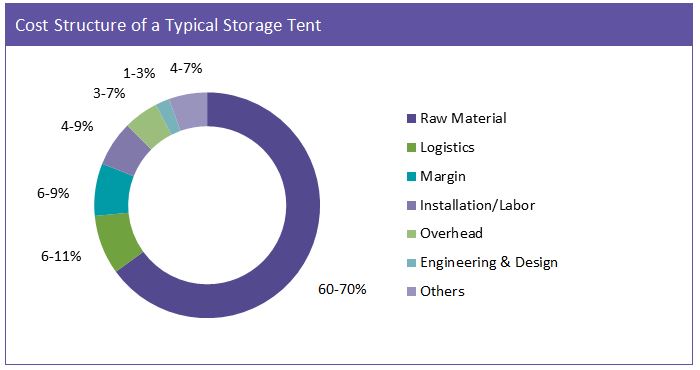
Source: Beroe Analysis
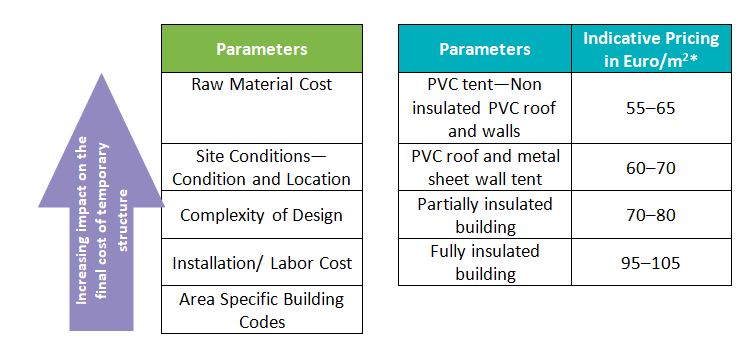
*Prices are exclusive of VAT for a temporary structure without ground works and accessories. Purchase: excluding lifting equipment, and installation and transportation costs. Hire: excluding lifting equipment, and installation/ deinstallation and transportation costs.
Climatic conditions such as snow and wind, and span and structure height might result in increase in prices.
Below is the comparison of cost breakup based on region (sector-wise):
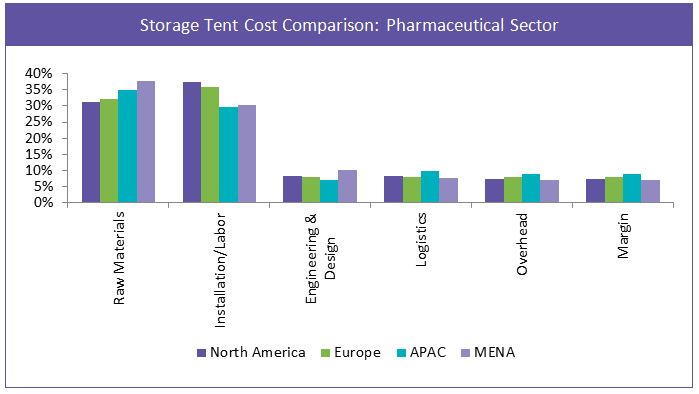
Source: Beroe Analysis, Expert Input
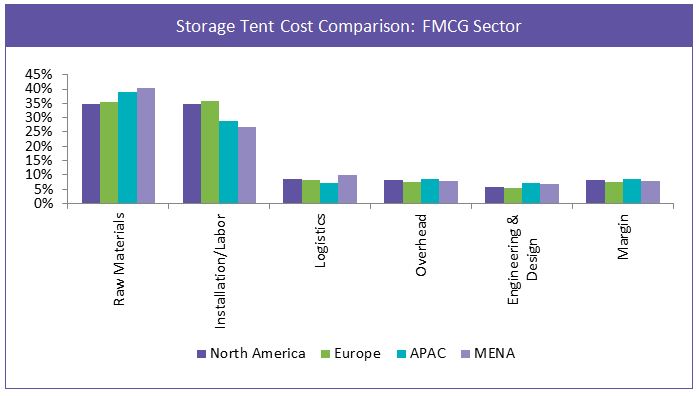
Source: Beroe Analysis, Expert Input
The breakup costs mentioned for temporary storage tents in all regions are mostly dependent on external factors such as the quality of products available in the market, labor conditions, climatic conditions, etc.
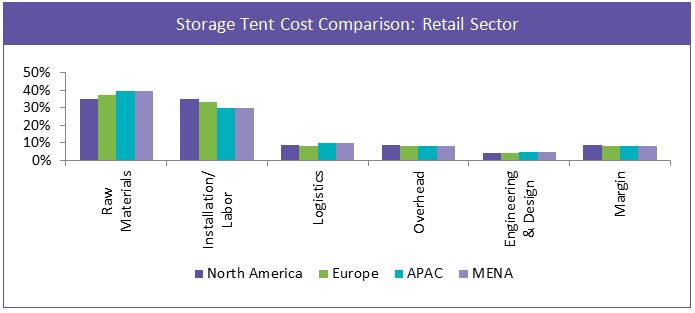
Source: Beroe Analysis, Expert Input
Adoption of Temporary Storage Tents
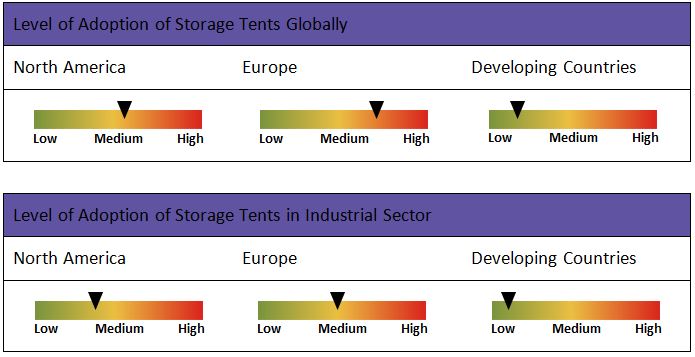
|
Pros |
Cons |
|
Reduced wastage of material |
Logistics challenges when the structure is bulky |
|
Higher quality control and precision |
Restrictions on the span and configurations |
|
Labor team is intact, and if planned properly, economies of scale can be leveraged to save costs |
If new to the process, negotiating on profit margins, overheads, etc., will be difficult due to lower transparency |
|
Higher safety of laborers |
Renovation, if required, will be more difficult as there will be fewer players in the market |
|
Lesser time to install |
|
Factors affecting Overall Cost
The variation in cost across countries include the various components that affect the overall cost after the product leaves the manufacturing site. Some cost components are logistics, installation, etc.
|
Impact of Raw Material Cost |
Impact of Installation Cost |
Other Factors affecting Cost |
|
|
|
Temporary Storage Tents – Financial Benefits
- Reduced Construction Cost: This approach enables cost savings anywhere between 5-30 percent compared to other traditional methods of construction. This cost saving arises as a result of reduced labor force requirements onsite, economies of scale which can be achieved in procuring raw materials, and reduction in wastage of materials, etc.
- Cost Savings in Building Maintenance: Storage tents often incorporate a number of building features, like natural and LED lighting, which aim at improving the overall energy efficiency of the building, reducing building maintenance cost. Temporary warehouse tents offer a significant amount of cost savings in annual construction maintenance costs compared to their counterparts.
- Tax Benefits: Although there are no direct tax benefits for tents in developing countries like India, China, and Brazil, owners can use this approach to gain credits for green buildings and access tax benefits associated with such buildings. They also offer an added tax benefit because they have a higher property value depreciation rate compared to a traditional building, thereby, reducing property tax.
- Faster Turnaround Times: Quick construction schedules associated with the tent assembly approach enable the project owner to gain quicker access to the storage/warehouse facility. This provides the clients a quick solution for their requirements. This leads to a quick turnaround time.
- Reusability and Resellability: These tents can be dismantled and relocated/reused at another location. It also permits an easy extension of buildings whenever needed. Tents can also be resold when they are not required anymore. This aspect of tent installation increases financial benefits for the end user.
Is it a Permanent Solution?
Temporary storage units are being used as semi-permanent and permanent storage solutions by companies in the industrial sector (automotive, FMCG, F&B)
Permission is required if:
-
-
- The height is more than 5 meters/ if it is within 10 meters of a boundary wall
- The tent is taller than the highest building within 15 meters of boundary
-
These tents can be used as efficient storage spaces on a long-term basis, and are preferred by industrial clients owing to the time and cost effectiveness of the solution.
References
https://www.temporarywarehouse.com/temporary-warehouse-cost-advantages/
https://www.shelterlogic.com/6-benefits-to-using-a-temporary-storage-solution/
https://codes.iccsafe.org/content/IBC2018/chapter-31-special-construction?site_type=public –
https://sso.agc.gov.sg/SL-Supp/S807-2018/Published/20181212?DocDate=20181212
https://www.abcb.gov.au/Resources/Publications/Education-Training/Temporary-Structures
https://archive.org/details/za.sans.10400.a.2010
https://www.herchenbach.co.uk/temporary-buildings/prices.htm
https://www.logisticsmiddleeast.com/article-13705-case-study-temporary-vs-permanent-warehouses
Recommended Reads:
Related Insights:
View All
Get more stories like this
Subscirbe for more news,updates and insights from Beroe






